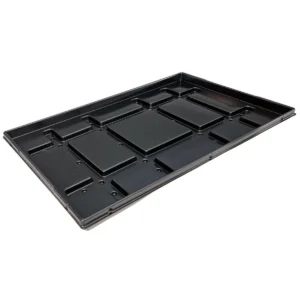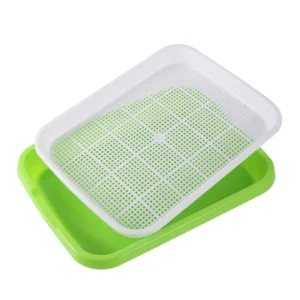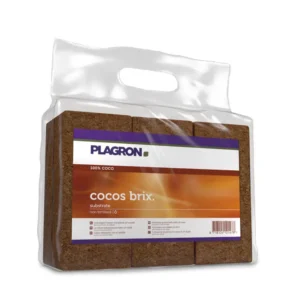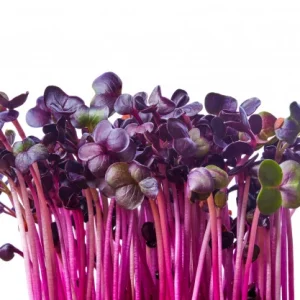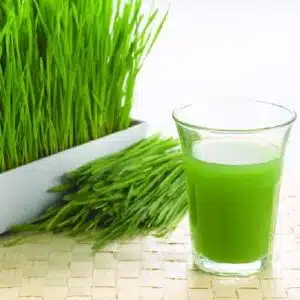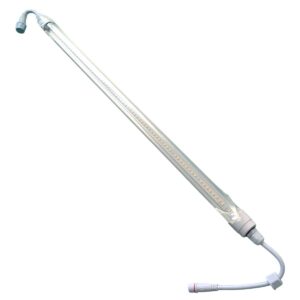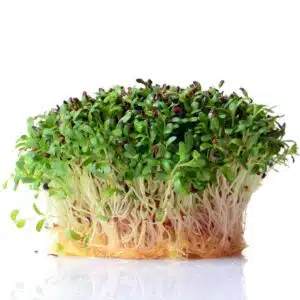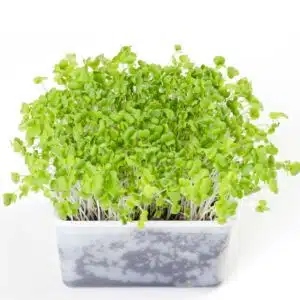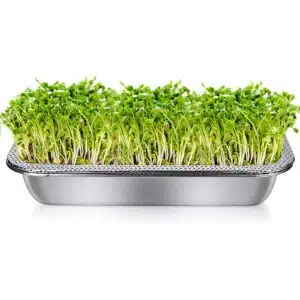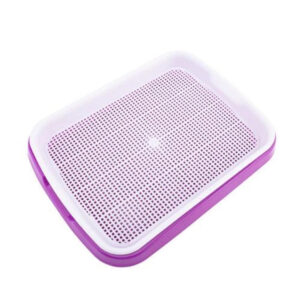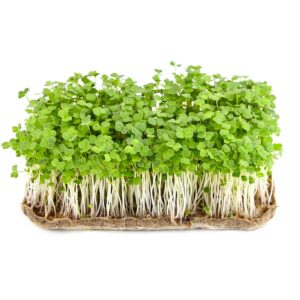This website uses cookies so that we can provide you with the best user experience possible. Cookie information is stored in your browser and performs functions such as recognising you when you return to our website and helping our team to understand which sections of the website you find most interesting and useful.
Micro greens
-
- Sale!
Small sprouting tray set for growing microgreens Green/white 22.7×14.5×2.5cm
-
DKK 27,00Original price was: DKK 27,00.DKK 12,00Current price is: DKK 12,00. - Add to basket
Item no.: 28094 -
Underwatering trays for Danish seed trays
- DKK 49,95
- Add to basket
Item no.: 28048 -
- Out of Stock
SunLight Pro-Gro T8 grow light luminaire 12Watt 60cm
- DKK 339,00
- Read more
Item no.: 26074 -
-
Coconut mould - Plagron Cocos Brix - Coconut soil
- DKK 28,00
- Add to basket
- Rated 5.00 out of 5
Item no.: 28059 -
- Sale!
Big Plant Science A+B Liquid Fertiliser offer
-
DKK 190,00Original price was: DKK 190,00.DKK 169,50Current price is: DKK 169,50. - Add to basket
Item no.: 26053 -
- Out of StockSale!
SunLight Pro-Gro T8 grow light luminaire 20Watt 90cm
-
DKK 437,00Original price was: DKK 437,00.DKK 349,49Current price is: DKK 349,49. - Read more
Item no.: 26069 -
-
Sprouting tray set for growing microgreens Green/white 33.7×24.5x5cm
- DKK 45,95
- Add to basket
Item no.: 28092 -
Mini greenhouse for QuickPot Danish seed trays 8cm lid
- DKK 37,95
- Add to basket
Item no.: 28042 -
Sweet Pea seeds for microgreens, Tendril, 100% Organic
- DKK 30,00 – DKK 799,00
- Select options This product has multiple variants. The options may be chosen on the product page
Item no.: 28112 -
Genuine Broccoli Calabrese seeds, MG, 100% Organic
- DKK 58,00 – DKK 8.500,00
- Select options This product has multiple variants. The options may be chosen on the product page
Item no.: 28109 -
Organic Peas for microgreens and pea shoots
- DKK 49,00 – DKK 958,00
- Select options This product has multiple variants. The options may be chosen on the product page
Item no.: 28064-1 -
Beetroot seeds - 100% Organic seeds
- DKK 55,00 – DKK 7.500,00
- Select options This product has multiple variants. The options may be chosen on the product page
-
Coconut mould - Plagron Cocos Brix 6x9L - Coco Coir
- DKK 149,95
- Add to basket
Item no.: 28093 -
Lid for Sprout Tray Set, transparent
- DKK 29,95
- Add to basket
Item no.: 28095 -
Socket outlet Day clock without earth
- DKK 89,00
- Add to basket
Item no.: 18050 -
Organic Sunflower seeds for microgreens
- DKK 86,00 – DKK 1.260,00
- Select options This product has multiple variants. The options may be chosen on the product page
Item no.: 28061 -
- Sale!
Microgreen tray with holes 35mm
-
DKK 65,00Original price was: DKK 65,00.DKK 59,00Current price is: DKK 59,00. - Add to basket
Item no.: 28045 -
Organic Radish Seeds - Red Radish Sprout
- DKK 59,95 – DKK 5.000,00
- Select options This product has multiple variants. The options may be chosen on the product page
Item no.: 28139 -
Wheatgrass seeds, Organic for microgreens
- DKK 30,00 – DKK 800,00
- Select options This product has multiple variants. The options may be chosen on the product page
Item no.: 28111 -
Organic green Daikon radish seeds
- DKK 23,00 – DKK 3.800,00
- Select options This product has multiple variants. The options may be chosen on the product page
-
Sprouting tray set for growing microgreens Blue/white 33.7×24.5x5cm
- DKK 45,95
- Add to basket
Item no.: 28091 -
SunLight Pro-Gro T8 grow light fixture 9Watt 60cm
- DKK 249,00
- Add to basket
Item no.: 26085 -
Organic Broccoli Raab seeds MG
- DKK 49,00 – DKK 2.550,00
- Select options This product has multiple variants. The options may be chosen on the product page
-
- Sale!
Microgreen tray with holes 48mm
-
DKK 69,00Original price was: DKK 69,00.DKK 65,00Current price is: DKK 65,00. - Add to basket
Item no.: 28046 -
SunLight Pro-Gro T8 grow light fixture 18Watt 120cm
- DKK 249,00
- Add to basket
Item no.: 26086 -
Bamboo fibre mat for microgreen growing 29x20cm - 5 pcs.
- DKK 69,95
- Add to basket
Item no.: 28215 -
Bamboo fiber mat for microgreen cultivation
- DKK 19,95
- Add to basket
Item no.: 28238 -
- Sale!
Microgreen Garden – Starter kit for healthy microgreen cultivation
- DKK 399,00 – DKK 1.000,00
- Select options This product has multiple variants. The options may be chosen on the product page
Item no.: 28180 -
Grow light fixture holder
- DKK 249,00
- Add to basket
Item no.: 26076 -
Organic Red Coral Radish Seeds (red stem) - 500g
- DKK 110,00
- Add to basket
Item no.: 28071 -
Lucerne (Alfalfa) - Organic Seeds
- DKK 29,00 – DKK 3.600,00
- Select options This product has multiple variants. The options may be chosen on the product page
-
Mizuna Green Japanese seeds for Delicious Microgreens
- DKK 40,00 – DKK 489,00
- Select options This product has multiple variants. The options may be chosen on the product page
-
Bamboo fibre mat for microgreen growing 20x12cm 5pcs.
- DKK 39,95
- Add to basket
Item no.: 28214 -
Organic Red Coral Radish Seed (red stem) - China rose
- DKK 29,95 – DKK 799,00
- Select options This product has multiple variants. The options may be chosen on the product page
Item no.: 28172 -
Organic Mung Bean Seeds for Delicious Microgreens
- DKK 65,00 – DKK 1.900,00
- Select options This product has multiple variants. The options may be chosen on the product page
Item no.: 28136 -
Organic Red Cabbage Seeds, 500g
- DKK 200,00
- Add to basket
Item no.: 28075 -
Microgreen starter kit, light, tray, growing medium, organic seeds
- DKK 450,00
- Add to basket
Item no.: 28119 -
Mizuna Red seeds for Delicious Microgreens
- DKK 50,00 – DKK 872,00
- Select options This product has multiple variants. The options may be chosen on the product page
Item no.: 28137 -
Organic chickpea seeds, suitable for Delicious Microgreens
- DKK 49,00 – DKK 1.900,00
- Select options This product has multiple variants. The options may be chosen on the product page
Item no.: 28135 -
- Sale!
Germination trays for microgreens with holes 20mm
-
DKK 69,00Original price was: DKK 69,00.DKK 62,00Current price is: DKK 62,00. - Add to basket
Item no.: 28044 -
Organic white mustard seeds for Delicious Microgreens
- DKK 143,00 – DKK 3.600,00
- Select options This product has multiple variants. The options may be chosen on the product page
Item no.: 28131 -
304 stainless steel germination tray for growing microgreens
- DKK 376,00
- Add to basket
Item no.: 28127 -
Sprouting tray for growing microgreens purple/white
- DKK 45,95
- Add to basket
Item no.: 28096 -
- Out of Stock
Organic Radish Seeds - Red, 500g seeds
- DKK 149,00
- Read more
Item no.: 28063 -
-
Arugula seeds for microgreens - organic
- DKK 135,00 – DKK 1.649,00
- Select options This product has multiple variants. The options may be chosen on the product page
Item no.: 28171 -
Green Lentil - Organic Seeds for Delicious Microgreens
- DKK 86,00 – DKK 2.200,00
- Select options This product has multiple variants. The options may be chosen on the product page
Item no.: 28133 -
Red Lentil - Organic Seeds Microgreen
- DKK 71,00 – DKK 1.900,00
- Select options This product has multiple variants. The options may be chosen on the product page
- Rated 5.00 out of 5
Item no.: 28134 -
Organic Fenugreek Seeds for Healthy Microgreens
- DKK 47,95 – DKK 1.400,00
- Select options This product has multiple variants. The options may be chosen on the product page
-
Big Plant Science - Complete Fertiliser Kit x5 offer (A,B,X,Y,Z)
- DKK 825,00
- Add to basket
Item no.: 26055 -
- Sale!
Microgreen small starter pack, light, tray, clock, growing media
-
DKK 655,00Original price was: DKK 655,00.DKK 497,00Current price is: DKK 497,00. - Add to basket
Item no.: Start-Micro-1 -
Germination tray for Microgreens with 6 compartments
- DKK 47,00
- Add to basket
Item no.: 28169 -
Azuki Bean Organic seeds for Delicious Microgreens
- DKK 41,00 – DKK 1.199,00
- Select options This product has multiple variants. The options may be chosen on the product page
- Rated 4.00 out of 5
-
Hydroponic microgreen growing system
- DKK 9.995,00
- Add to basket
Item no.: MICROGREEN1
Microgreen - Microgreen cultivation
Microgreens, also known as micro greens, are the next big thing when it comes to edible plants. Microgreens are young plants and herbs that can be eaten once the cotyledons have developed, even if the plants are not yet fully developed. Mini-greens can be harvested 1-2 weeks after germination and include both the rhizome and leaves, but not the radicle, which is left in the growing medium/soil.
The mini plants have a delicious aromatic flavour and the nutrient content is much more concentrated than in the growing plants. These mini plants come in many different colours and textures. Microgreens are considered to be baby plants, which fall between fresh sprouts and baby greens/mini greens.
However, this does not mean that microgreens are the same as sprouts, which do not have true leaves. Sprouts have a shorter growth cycle of about 2-7 days compared to microgreens, whereas microgreens can usually be harvested after about 7-21 days after germination, when the plant's true cotyledons have emerged. After about 7-21 days, the plant has achieved the same flavour as the finished vegetable, e.g. broccoli or peas.
Trays for growing microgreens
To get the most out of your microgreen cultivation, you may want to use some microgreen trays. The trays have the advantage of providing the optimal growing conditions for your micro plants, including the perfect drainage of excess water so the seeds and tiny soft roots don't rot or mould in your microgreens.
Host Plantelys.dk trays are available in many different versions. The low 25 mm trays are suitable for small plants such as broccoli or radishes, whereas larger plants such as pea sprouts should have high 35 mm trays that better support the tall, thin plants.
Microgreen food and fertiliser for microgreens
If you're growing microgreens, the roots of the sprouts should have something to hold the plant firmly as the plants grow. There are several good options, such as Cocos fibre, bamboo, hemp mats, fibre mats, sphagnum, rockwool and specially designed planting trays with netting.
But many also choose to experiment with paper towels, cotton wool, paper and garden soil. However, using garden soil/organic seed soil is not recommended as it contains bacteria and other harmful substances that can contaminate and destroy plants and make them inedible.
Organic seeds for microgreens
Before you can start growing microgreens, you need to acquire a lot of seeds. It's important to choose organic seeds, as virtually all seeds available in the supermarket are usually treated with a fungicide that is toxic to humans.
Commercial sales of equipment and seeds for microgreen production
Contact us when purchasing larger quantities of equipment, Light to microgreen, starter packs or organic seeds for microgreen production.



